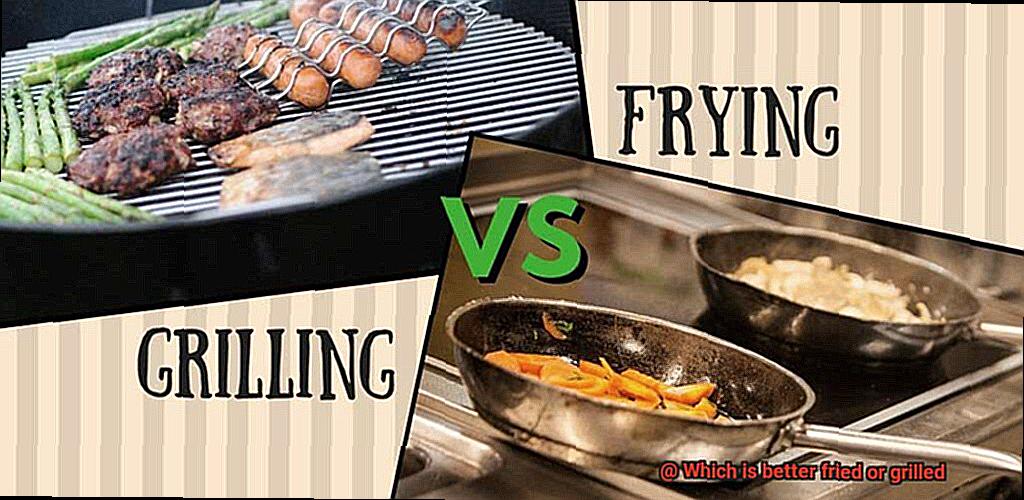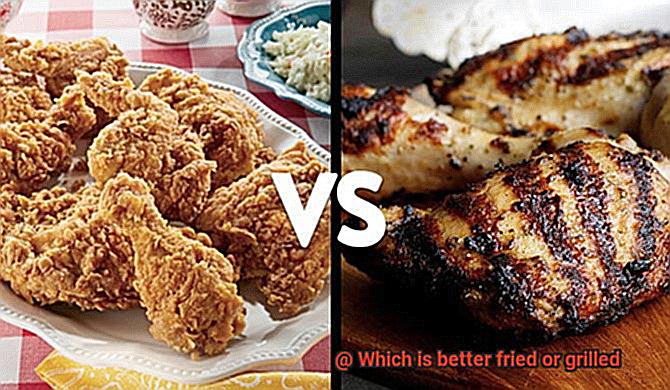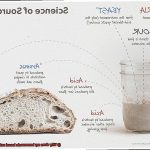Fried or grilled? It’s the age-old question that every food lover and health enthusiast has pondered over. Some swear by the crispy, indulgent flavor of fried foods, while others opt for the healthier, leaner option of grilled foods. But which one is truly better?
- Let’s face it: both fried and grilled foods have their pros and cons. Fried foods are notorious for being high in calories, unhealthy fats, and cholesterol. Grilled foods, on the other hand, offer a healthier alternative by being low in fats and calories. However, they may lack that savory flavor that we all crave from fried foods.
- But here’s the good news: you don’t have to pick sides. There are ways to enjoy both types of cuisine without sacrificing your health goals. Whether you’re looking to indulge in some crispy goodness or want to stick to a nutritious diet, there’s a way to make it happen.
In this post, we’ll explore the benefits and drawbacks of both grilled and fried foods. We’ll also provide you with tips on how to make healthier versions of your favorite fried dishes and share some grilling techniques that will take your meals to the next level. And if you’re feeling adventurous, we’ve got some mouth-watering recipes that you can try at home.
So buckle up and get ready to learn more about which is better: fried or grilled.
Contents
Pros and Cons of Frying
Frying is a popular cooking method that involves submerging food in hot oil. While it can produce delectably crispy and golden-brown results, it also comes with some potential disadvantages to consider. In this article, we will examine the pros and cons of frying compared to grilling, so that you can make an informed decision based on your individual preferences and dietary needs.
Let’s begin with the advantages of frying:
- Crispy texture: Frying can create a crispy texture on the outside of food, which is particularly desirable for foods like fried chicken or French fries. The high heat of the oil causes a chemical reaction that creates a crunchy, golden-brown crust on the exterior while keeping the inside moist and tender.
- Quick cooking time: Frying is typically a speedy cooking method, which can be convenient when you’re pressed for time. Small pieces of food like chicken wings or shrimp can be cooked in just a few minutes, making it an excellent choice for busy weeknights or gatherings.
- Versatility: Frying can be used for a wide range of foods, from vegetables to meats to desserts. It’s a versatile cooking method that provides you with the freedom to experiment with various recipes and ingredients.
Now let’s delve into the downsides of frying:
- High calorie count: Frying adds a significant amount of fat and calories to food, which can contribute to weight gain and other health issues. When food is submerged in hot oil, it absorbs the oil and becomes greasy, adding unnecessary calories to your diet.
- Messy cleanup: Frying can be messy, with oil splatters and a greasy residue left behind on cooking equipment. Cleaning up after frying can be time-consuming and requires extra effort to remove all traces of oil from your kitchen.
- Health risks: Consuming fried foods regularly has been linked to an increased risk of heart disease, stroke, and other health issues. The high amount of saturated and trans fats in fried foods can raise cholesterol levels and lead to inflammation in the body.
Pros and Cons of Grilling
As the temperature rises during the summer months, so does the frequency of using the grill. Grilling is a popular cooking method that involves cooking food over an open flame or heat source, such as a propane or charcoal grill. Grilling has several advantages, such as the unique flavor it adds to food and its ability to cook food quickly and evenly. However, there are also potential downsides to grilling that should be considered.
First, let’s savor the positives. One of the main benefits of grilling is the flavor it imparts to food. The smoky, charred taste is one that many people find irresistible. Additionally, grilling helps lock in the natural juices of meat, making it moist and tender. Moreover, grilled food can be enhanced with marinades and rubs, offering a range of flavors.
Another advantage of grilling is its speed. With high heat generated by grills, food can cook quickly and evenly, making it an ideal choice when cooking for large groups or when time is limited.

However, there are also some potential drawbacks to consider when it comes to grilling. One concern is the formation of carcinogens that can increase the risk of cancer. When meat is cooked at high temperatures, such as those used in grilling, it can create compounds called heterocyclic amines (HCAs) and polycyclic aromatic hydrocarbons (PAHs). These compounds have been linked to cancer in animal studies and may increase the risk of certain types of cancer in humans.
Another potential downside to grilling is its impact on the environment. Charcoal grills, in particular, can release large amounts of carbon monoxide and other pollutants into the air. If lighter fluid is used to start the grill, it can release volatile organic compounds (VOCs) that contribute to smog and air pollution.
Pros:
- Unique smoky flavor
- Ability to lock in natural juices
- Quick cooking time
- Allows for use of marinades and rubs
Cons:
- Formation of harmful carcinogens
- Environmental impact
To enjoy the benefits of grilling while minimizing the risks, it’s important to take certain steps. For example, avoid charring your food and cook at lower temperatures whenever possible to minimize the formation of harmful compounds. Additionally, consider using environmentally-friendly grilling methods or alternatives such as electric or gas grills.
Calories, Fat Content, and Nutrition
When it comes to calories, fat content, and nutrition, it’s important to be mindful of our cooking methods.
Fried foods may taste great, but they are often high in calories and unhealthy fats. And that’s not all – frying food at high temperatures can cause the formation of harmful compounds like acrylamide and PAHs, which have been linked to cancer risk. So, it’s wise to limit our intake of fried foods.
Grilling, on the other hand, is often considered a healthier option because it allows excess fat to drip off the food, resulting in lower fat content. Grilling also helps retain the nutrients in the food, making it a more nutritious choice overall. However, there are still some things to keep in mind when grilling.
It’s essential to note that not all grilled foods are healthy. Grilling meat at high temperatures can lead to the formation of harmful compounds like HCAs and PAHs, which can increase cancer risk if consumed regularly in large amounts. But don’t worry – there are ways to make your grilling healthier.
Here are some tips for making healthier choices when grilling:
- Choose leaner cuts of meat: Opt for leaner cuts of meat like chicken breast or turkey burgers instead of fatty meats like ribs or sausages.
- Marinate your meat: Marinating your meat before grilling can help reduce the formation of harmful compounds.
- Avoid charring your food: Charring your food may give it a smoky flavor, but it can also increase the formation of harmful compounds.
- Cook at lower temperatures: Cooking at lower temperatures can help reduce the formation of harmful compounds.
Retaining Natural Flavors and Nutrients
The solution lies in the cooking method you choose. As an expert in retaining natural flavors and nutrients, I strongly recommend grilling over frying as the superior choice.
When it comes to taste, grilling is a clear winner. Unlike frying that requires added oils and breading, grilling allows food to cook in its own juices, resulting in a more authentic flavor that’s sure to tantalize your taste buds.
But the benefits don’t end there – grilling is also a healthier option for retaining natural nutrients. High-heat cooking methods, like frying, can easily strip away important minerals and vitamins, but grilling ensures that these essential nutrients remain intact. Grilled vegetables, for example, have increased vitamin C content due to the caramelization process.
However, proper grilling techniques are crucial to maintaining nutrient retention. Overcooking or charring food can lead to the loss of essential nutrients and even create harmful compounds like polycyclic aromatic hydrocarbons (PAHs) and heterocyclic amines (HCAs). To avoid these risks, it’s recommended to grill over lower heat and marinate meat with ingredients like vinegar or citrus beforehand to reduce the formation of harmful compounds.
In summary, grilling is not only the tastier option but also the healthier one for retaining natural flavors and nutrients. So next time you’re choosing between fried or grilled options, opt for the grill for a satisfyingly nutritious meal. Remember these top tips to ensure your grilled meals are always packed with flavor and nutrition:
Smoky Flavor and Charred Texture
As an expert in natural flavors and nutrients, I can confidently say that grilling is the ultimate way to achieve that unmatched culinary experience.
Let’s dive into the reasons why grilling is king when it comes to creating that mouthwatering smoky flavor and charred texture. Firstly, the smoky flavor comes from the smoke produced by cooking food over an open flame or hot surface. As meat cooks, the dripping fat and juices hit the hot surface, causing smoke to rise up and infuse the meat with a rich, smoky flavor. This process results in an aroma so tantalizing that your taste buds will be begging for more.
Secondly, grilling creates a charred texture that is highly sought after by food enthusiasts. The charred bits on the outside of grilled meats add a depth of flavor and textural contrast that simply cannot be achieved through frying. While frying may create a crispy exterior, it cannot compare to the unique flavors and textures offered by grilling.
But let’s not discredit frying entirely – it may still be an excellent option for certain foods. However, it simply cannot replicate the authentic smoky flavor and charred texture that grilling provides.
Crispy Texture from Frying
Frying is a clear winner when it comes to creating a crispy texture, as submerging food in hot oil creates a crunchy exterior while maintaining a moist and tender interior.
There are several key factors to consider when trying to achieve the perfect crispy texture through frying. Firstly, temperature is crucial, and using a thermometer to ensure the oil is at the right temperature before adding your food is essential. Generally, a temperature range of 350-375 degrees Fahrenheit works well for most foods.
The type of oil used is also important. Oils with a high smoke point, such as vegetable or peanut oil, are ideal for frying. These oils can withstand high temperatures without breaking down or producing harmful compounds.
In addition to temperature and oil type, the coating on your food can also greatly affect its crispiness. A light coating of flour or breadcrumbs can help create a crunchy exterior while keeping the inside moist and tender.
While frying may be the ultimate technique for achieving that perfect crispy texture, it’s important to keep in mind that indulging in fried foods excessively can be detrimental to one’s health. Moderation is key when consuming these high-calorie and unhealthy fat-laden treats.
Dietary Needs and Personal Preferences
When it comes to choosing between fried and grilled food, there are a few crucial factors that come into play – dietary needs and personal preferences. While grilled food is often healthier for individuals who are watching their fat intake or calorie consumption, personal preferences also play a significant role in deciding which option is better suited for you.
If you’re someone who follows a particular diet, such as paleo or keto, then grilled food might be your go-to choice. Grilling enables the natural flavors and textures of the food to be retained, making it an excellent option for those who want to stick to their dietary plan. Additionally, grilling allows excess fat to drip off the meat, making it leaner and healthier. Vegetables also retain more nutrients when grilled as they are not submerged in oil or other cooking liquids.
However, personal preferences can also impact your decision when choosing between fried and grilled food. Some people prefer the crispy exterior and tender interior of fried dishes, while others enjoy the smoky flavor and texture that grilling provides. It’s important to note that fried food generally has higher calories and fat content than grilled food, so it’s essential to consume them in moderation if you’re trying to maintain a healthy diet.
Ultimately, the decision of whether fried or grilled food is better for you depends on your individual needs and preferences. It’s crucial to consider both factors when making food choices and incorporate a variety of cooking methods into your diet for optimal health and enjoyment.
To make things easier for you, we have compiled a list of benefits for both fried and grilled options:
Benefits of Grilled Food:
- Retains natural flavors and textures
- Allows excess fat to drip off, making it leaner
- Vegetables retain more nutrients
Benefits of Fried Food:
- Crispy exterior with a tender interior
- Provides a unique flavor profile
- Can be a comfort food option for some individuals
1SJxzSCprcA” >
Conclusion
When it comes to the great fried vs. grilled debate, there’s no clear winner. Fried foods offer a tantalizingly crispy texture and unique flavor profile, but they also come with a hefty calorie count and unhealthy fats. On the other hand, grilled foods are often lower in fats and calories while preserving natural flavors and textures. However, grilling can produce harmful compounds like HCAs and PAHs if not done correctly.
But don’t fret – you don’t have to choose between your taste buds and your health goals. By following proper grilling techniques such as marinating meat beforehand, using lower heat, and selecting leaner cuts of meat, you can minimize the risks associated with grilling while still savoring its benefits.
Similarly, by using the right temperature, oil type, and coating for your fried food, you can achieve that perfect crispy texture without going overboard on calories or unhealthy fats.
Ultimately, whether fried or grilled food is better for you depends on your individual needs and preferences. It’s essential to consider both factors when making food choices and incorporate a variety of cooking methods into your diet for optimal health and enjoyment. So go ahead – indulge in some crispy goodness or stick to a nutritious diet.






